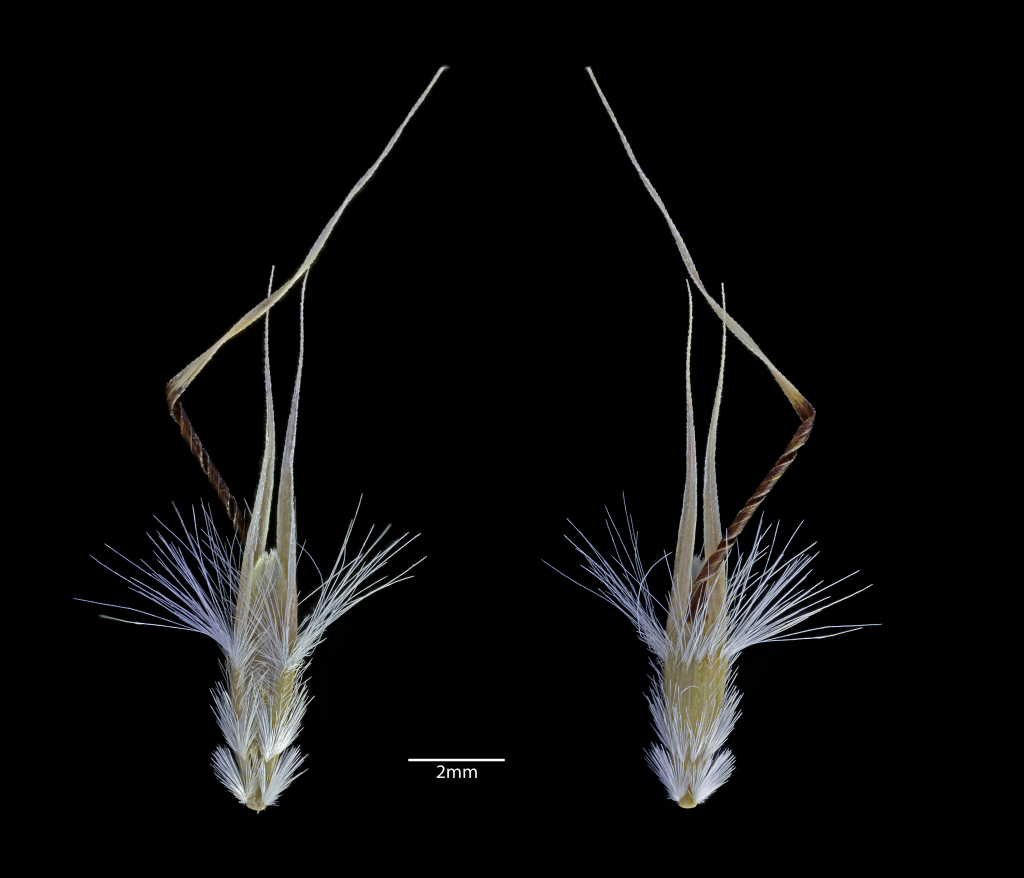Rytidosperma aff. caespitosum (South-west swamps)
Narrowly tufted or very shortly rhizomatous perennial. Leaves smooth and glabrous, rarely sparsely and shortly pilose; ligule a row of hairs c. 1 mm long, with marginal tufts to c. 2 mm long; blade flat to loosely inrolled in vivo, c. 12–25 (35) cm long, 1.5–2.25 mm wide. Culms erect, usually purplish at least around the nodes; panicle linear to narrowly ovate, with spikelets usually overlapping but rarely dense, 6–13 cm long. Spikelets 4–7-flowered, the uppermost (if florets >4 in number) often reduced and sterile; glumes initially strongly purpled, ageing to straw-coloured, subequal, 14–22 mm long; body of lemma ±oblong in outline, 2–4 mm long (reduced, sterile apical florets often shorter), shining and golden- to chestnut-brown at maturity, with hairs in two complete rows (not including the callus tufts), usually with some sparse hairs scattered between the rows; hairs of upper row c. 2–3 mm long, extending to about midway of twisted part of central awn; hairs of lower series c. 0.5–1.5 mm long, usually only reaching about halfway to the upper row; lateral lobes erect, usually purplish, 4–6 mm long, ±evenly tapered from base to setiform tips, strongly scabrous, not strongly exceeding the column of the central awn; central 9–17 mm long, dark brown and strongly twisted through the proximal 3–5.5 mm, c. 0.5 mm wide at base; palea ±oblong to narrowly obovate, exceeding sinus by c. 1 mm, very rounded-truncate, usually shallowly emarginate at apex, of thinner texture than lemma, but relatively firm, densely and shortly ciliate around margin and along keels.
VRiv, GipP. Known mostly from swampy vegetation in the far south-west (e.g. Kentbruck Heath, Gorae West, Dergholm), but also with an apparent outlier in outer eastern Melbourne near Kilsyth.
Specimens of this have previously been determined as Rytidosperma indutum (syn. R. procerum), and R. caespitosum. From the former it differs principally in the strongly purpled glumes and smaller shining-brown lemmas that have rows of shorter and less dense hairs, and relatively much shorter paleas that are rounded-truncate rather than tapered at the apex and much firmer textured than those of R. indutum. From the very variable R. caespitosum it differs in the shape of the ±oblong lemma outline (typically broadened distally in R. caespitosum), the narrower lateral lobes (lacking a pronounced basal dilation that is usually present in R. caespitosum) and the firm-textured, oblong to narrowly obovate palea. In the shining brown mature lemmas, the glabrous foliage and the swampy habitat, there is an approach to R. duttonianum. It is possible that more than one undescribed entity is covered by the above concept.
 Spinning
Spinning
